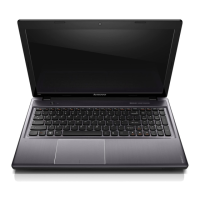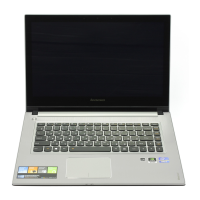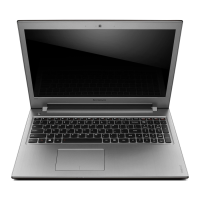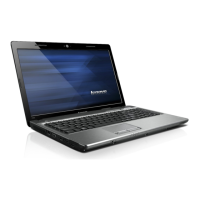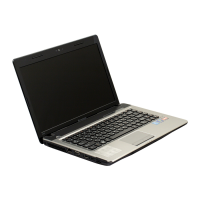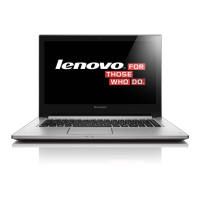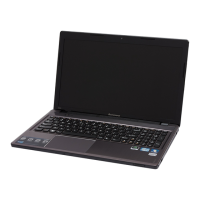Do you have a question about the Lenovo IdeaPad Z360 and is the answer not in the manual?
Details the top layout of the laptop, including buttons and indicators.
Illustrates and describes ports and slots on the left side of the laptop.
Illustrates and describes ports on the right side of the laptop, including audio and optical drive.
Shows and describes the front panel features like memory card slot and status indicators.
Details the rear panel, primarily the AC power adapter jack.
Explains the bottom components, including battery latch, SIM card slot, and drive compartments.
Guides users through initial setup, power connection, and OS configuration.
Explains how to check battery status and charge the battery for optimal use.
Describes the functionality and operation of the laptop's touchpad and its buttons.
Details keyboard features, including the numeric keypad and function key combinations.
Instructions for inserting and removing various types of memory cards.
Guide on connecting external devices using the computer's USB ports.
Information on enabling and using Bluetooth connectivity for wireless data transfer.
Explains dedicated keys like OneKey Rescue, Mute/Unmute, OneKey Theater, and Smart Noise Control.
Identifies and explains the meaning of various LED indicators on the computer.
Provides information on protecting the computer from theft and unauthorized use.
Guides on setting up and using passwords for system security.
Explains the automatic graphics switching for performance and battery life optimization.
Details how to establish an Internet connection using physical cables like Cable and DSL.
Explains different wireless technologies (Wi-Fi, WiMAX, Mobile Broadband) for Internet access.
Introduces the system for backing up and restoring data and system partitions.
Describes how to use the recovery software while the OS is running.
Explains how to access the rescue system when the OS fails to load.
Step-by-step instructions for safely removing and installing a laptop battery.
Detailed guide on how to replace the computer's hard disk drive.
Instructions for installing or upgrading the computer's RAM modules.
Steps to safely remove the CD/DVD drive from the computer.
Details the scope of coverage for defects in materials and workmanship and general terms.
Information on contacting Lenovo or service providers for support.
Outlines what service providers will do to diagnose and resolve issues.
Explains the policy for replacing defective products or parts.
Lists customer duties such as backing up data and providing access.
Details how Lenovo handles personal information during warranty service.
Lists situations and damages not covered by the warranty.
Defines the extent of Lenovo's liability for product loss or damage.
Explains dispute resolution processes and applicable consumer rights.
Provides warranty service information specific to different countries and regions.
Describes different service options like CRU, On-site, and Courier/Depot.
Information about ENERGY STAR compliance and power management features.
Compliance statements related to FCC, Industry Canada, and EU regulations.
| Bus type | DMI |
|---|---|
| Stepping | K0 |
| Tjunction | 105 °C |
| Processor cache | 3 MB |
| Processor cores | 2 |
| Processor model | i5-450M |
| System bus rate | 4.8 GT/s |
| Processor family | Intel® Core™ i5 |
| Processor series | Intel Core i5-400 Series |
| Processor socket | Socket 988 |
| Processor threads | 4 |
| Processor codename | Arrandale |
| Processing Die size | 81 mm² |
| Processor frequency | 2.4 GHz |
| Processor cache type | Smart Cache |
| Processor lithography | 32 nm |
| Processor manufacturer | Intel |
| PCI Express slots version | 2.0 |
| Processor boost frequency | 2.66 GHz |
| Processor operating modes | 64-bit |
| ECC supported by processor | No |
| PCI Express configurations | 1x16 |
| Thermal Design Power (TDP) | 35 W |
| CPU multiplier (bus/core ratio) | 18 |
| Maximum number of PCI Express lanes | 16 |
| Number of Processing Die Transistors | 382 M |
| Motherboard chipset | Intel® HM55 Express |
| HDD speed | 5400 RPM |
| HDD interface | SATA |
| Optical drive type | DVD-RW |
| Card reader integrated | Yes |
| Total storage capacity | 500 GB |
| Compatible memory cards | Memory Stick (MS), MMC, MS PRO, SD |
| Display surface | Gloss |
| Display diagonal | 13.3 \ |
| Display brightness | 200 cd/m² |
| Display resolution | 1366 x 768 pixels |
| Native aspect ratio | 16:9 |
| Type | PC |
| Graphics card family | NVIDIA |
| Internal memory | 2 GB |
| Memory clock speed | 1066 MHz |
| Internal memory type | DDR3-SDRAM |
| Maximum internal memory | 8 GB |
| Discrete graphics card model | NVIDIA® GeForce® 310M |
| Maximum graphics card memory | - GB |
| On-board graphics card model | Intel® HD Graphics |
| On-board graphics card base frequency | 500 MHz |
| On-board graphics card dynamic frequency (max) | 766 MHz |
| Audio system | HD |
| Speaker power | 4 W |
| Front camera resolution (numeric) | 1.3 MP |
| Bluetooth version | 2.1+EDR |
| Networking features | Fast Ethernet |
| Operating system installed | Windows 7 Home Premium |
| Sustainability certificates | ENERGY STAR |
| Battery life (max) | 5 h |
| Number of battery cells | 6 |
| Charging port type | DC-in jack |
| Serial ports quantity | 0 |
| USB 2.0 ports quantity | 3 |
| Cable lock slot type | Kensington |
| Product color | Black |
| Pointing device | Touchpad |
| Processor code | SLBTZ |
| Processor ARK ID | 49022 |
| Processor package size | rPGA 37.5x 37.5, BGA 34x28 mm |
| Graphics & IMC lithography | 45 nm |
| Supported instruction sets | SSE4.1/4.2 |
| Intel® Turbo Boost Technology | 1.0 |
| Physical Address Extension (PAE) | 36 bit |
| Depth | 219 mm |
|---|---|
| Width | 327 mm |
| Weight | 2000 g |
| Height (rear) | 34 mm |
| Height (front) | 20 mm |


